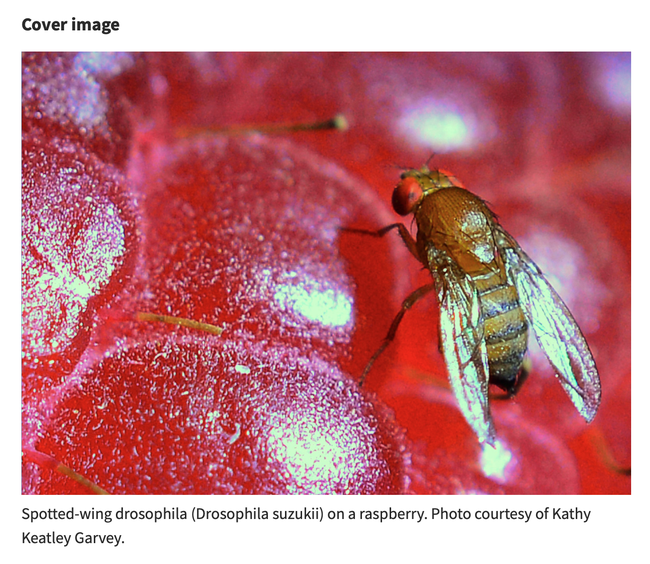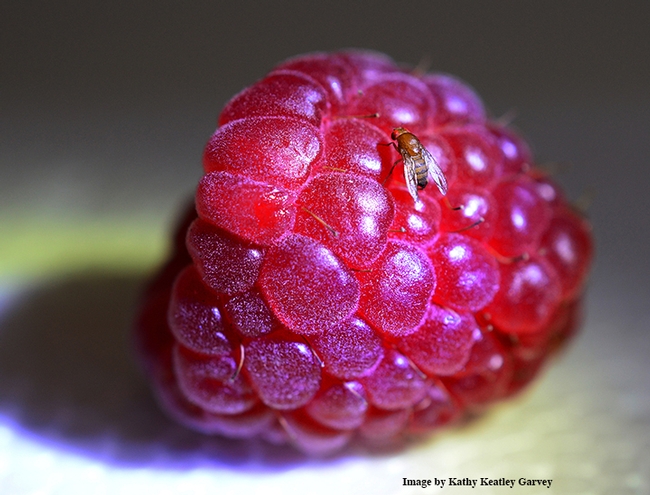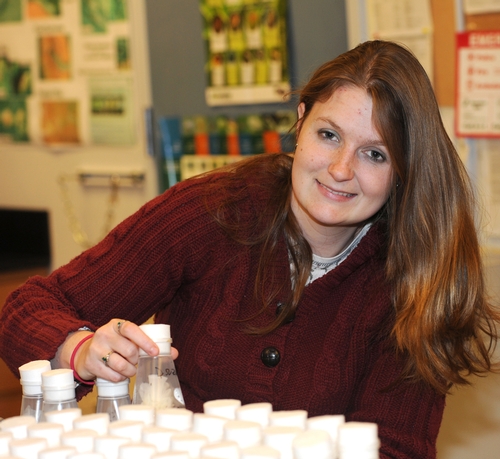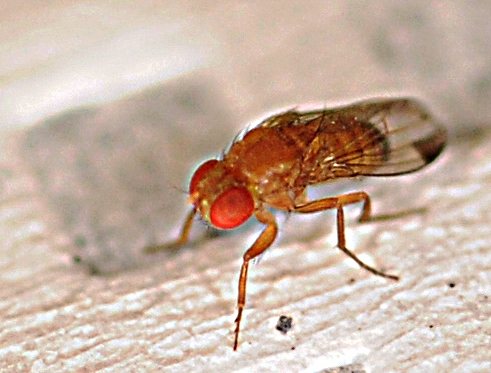Posts Tagged: spotted-wing drosophila
ESA Journal Targets the Spotted-Wing Drosophila
It was a major project, a long time coming, and what an excellent resource for those studying the...

The Cover
Zeroing in on the Spotted-Wing Drosophila
It's an invader that has long attracted attention--and alarm--in California agriculture. "The...

UC Davis postdoctoral researcher Brian Gress will discuss "Host Selection and Resistance Evolution in Drosophila Suzukii" at a UC Davis Department of Entomology and Nematology seminar at 4:10 p.m., Wednesday, Jan. 9 in 122 Briggs Hall.
Kent Daane Seminar: Spotlight on Spotted Wing Drosophila
(Editor's Note: If you missed the seminar, you can view it here on YouTube at...

Spotted Wing Drosophila, Drosophila suzukii, on raspberry. (Photo by Kathy Keatley Garvey)
Be on the lookout for spotted wing drosophila.
It's cherry growing season and a good time to begin looking for spotted wing drosophila (SWD), Drosophila suzukii. SWD is a small fruit fly that attacks soft-flesh fruit such as cherry, blueberry, raspberry, and blackberry. It first appeared in 2010, and its damage to fruit and increased management costs led to significant economic losses to cherry growers throughout California and the Pacific Northwest.
Unlike other fruit flies that infest rotted fruit, SWD attacks undamaged fruit. As cherry fruit begins to develop and starts to change color from light green to straw, SWD lays its eggs just under the skin of fruit, creating a small scar or a “sting.” One to three larvae may develop inside each cherry, feeding on the fruit and causing it to become brown and soft. Many times SWD flies are not noticed until fruit is mature, and by that time management is not very effective.
Prevention is the key, and one way to prevent damage is to monitor for the pest when it first becomes active. SWD can be monitored with several types of traps partly filled with apple cider vinegar to lure the pest. Monitor traps weekly through the end of harvest, and be sure to confirm the presence of SWD, as other Drosophila spp. may be present in trap catches. SWD males have a single dark spot on the tip of its wing and females have a large ovipositor. See the UC IPM Pest Management Guidelines for identification help and a dichotomous key.
Spotted wing drosophila is still a relatively new pest, and management information continues to change. UCCE Entomology Advisor David Haviland and other researchers have been working to provide what help they can. Haviland has designed a bucket trap called the “Haviland trap” and is working with others to field-test experimental lures for SWD. He's also studying a possible biological control agent. Research has led to new grower guidelines so that early season cherries can be produced and sold internationally. Check out the 2014 Recommendations for Sweet Cherry (PDF).
For management in backyard cherries or other urban areas, see the SWD Pest Note.
For more information about UC IPM's recent work, see the 2013 Annual Report.

An image of a spotted wing drosophila.

A cherry with spotted wing drosophila damage.

A trap used to monitor for the presence of spotted wing drosophila.
Tackling Spotted Wing Drosophila
Deep in the bowels of Briggs Hall on the UC Davis campus, entomology graduate student Kelly Hamby...

Kelly Hamby

Close-up of Drosophila